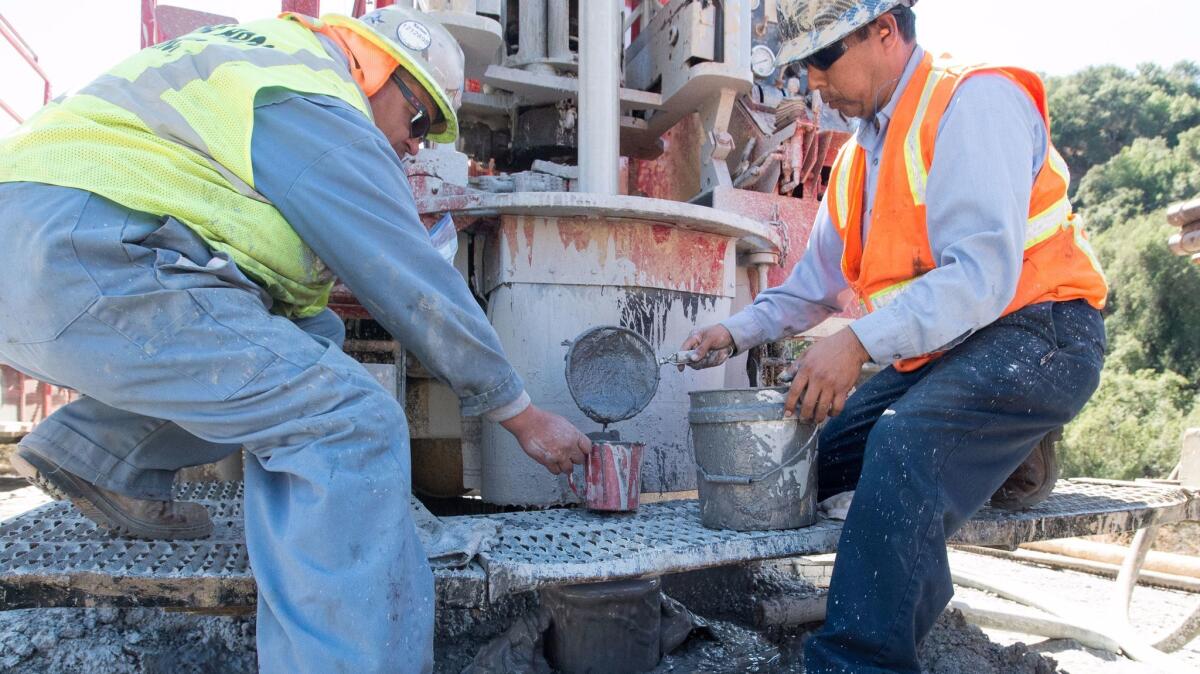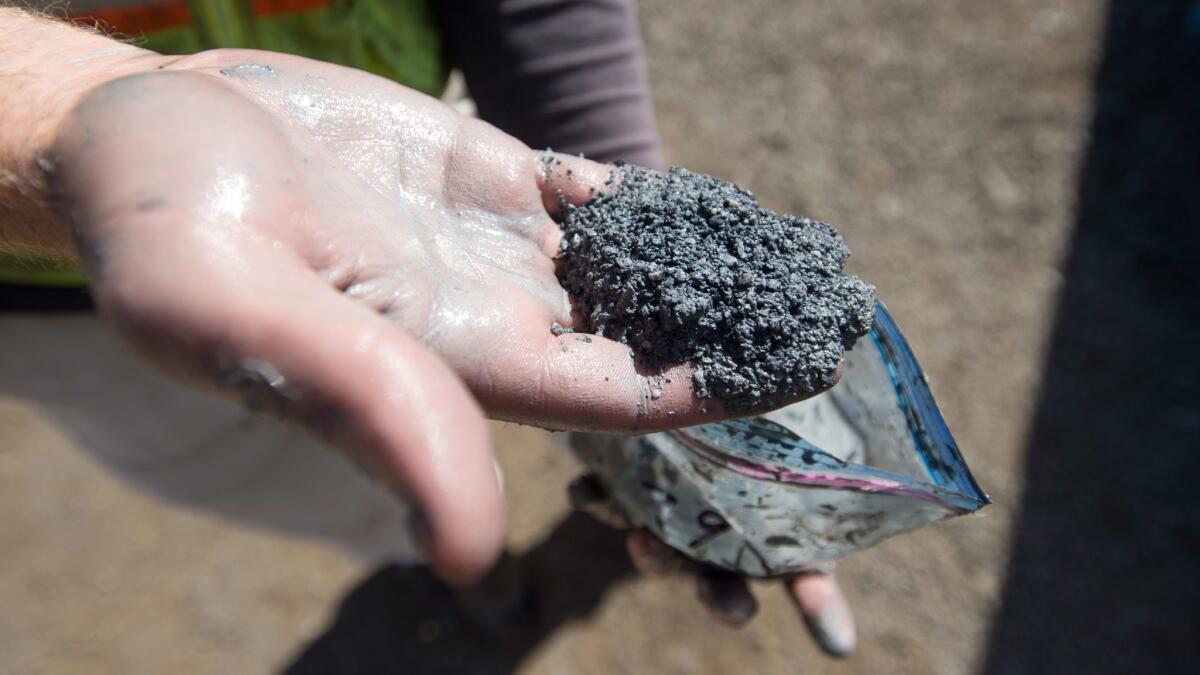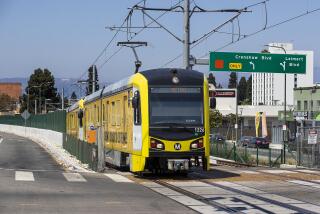A 13.5-mile tunnel will make or break Californiaâs bullet train

Californiaâs bullet train could cost taxpayers 50% more than estimated for the first 118 miles â as much as $3.6 billion more â according to a confidential federal report obtained by the Los Angeles Times. (Jan. 13, 2017)
When the first California bullet train pulls out of San Jose one day, a crucial part of the journey will be a 13.5-mile tunnel beneath the winding peaks and valleys of Pacheco Pass.
Trains will run at top speed along a straight and level route beneath the Diablo Range, shooting through the nationâs longest and most advanced transportation tunnel.
But the massive scope and complexity of the tunnel are at the heart of new concerns about the viability of the state project.
A Times analysis has found that tunnel construction could exhaust the $5.5-billion budget for the entire 54-mile segment from Gilroy to Chowchilla.
Some of the worldâs top tunnel experts put the cost of the tunnel at anywhere from $5.6 billion to $14.4 billion, reflecting the high cost of boring through tricky geology and seismically active areas.
The Gilroy-to-Chowchilla route also requires a 1.5-mile tunnel just east of Gilroy, itself a major infrastructure project.
âThis is not good news for taxpayers of California,â said William Ibbs, a UC Berkeley civil engineer who has consulted on similar rail projects around the world. âTunnels are expensive.â
Engineers at the California High-Speed Rail Authority are cautious but not worried. âWe donât see any problem,â said Scott Jarvis, chief engineer.
The authority said it is too early to have its own cost estimate because it has not done enough geological investigation and engineering analysis, said Randy Anderson, the agencyâs tunneling expert.
He added that engineering for previous tunneling for water lines shows they are in the ballpark.
But if construction costs grow and exhaust the projectâs budget, it could jeopardize plans for building the initial operating segment from San Jose to the Central Valley.
State officials acknowledge that unless they demonstrate a financially successful starter system, private investors will not commit money to help build the rest of the line to Los Angeles.
At best, the rail authorityâs existing funds are stretched thin. It has $21 billion to build the starter system.
The funds include $6.8 billion from a 2008 bond, $3.2 billion in federal grants, $5.3 billion from Californiaâs greenhouse gas fees through 2024, and $5.2 billion from bonds issued against greenhouse gas fees after 2024.
The plan to issue bonds supported by future greenhouse gas fees is the weak link.
Michael Thom, a public finance expert at USC, said those funds are not âa reliable source of revenueâ¦. I canât imagine a reason why a rational investor would take that risk.â
The rail authority initially planned to start building from Los Angeles but abandoned that plan in 2016 because it was too costly â ironically because of tunnels under the San Gabriel and Tehachapi mountains.
Under the current plan, the state wants to begin the 240-mile starter system in San Jose and end in an almond orchard south of Wasco. The state estimates the system would begin operating in 2025 and carry about 3 million passengers a year.
The rail authorityâs optimistic timetable estimates that the entire Los Angeles-to-San Francisco system, passing through Palmdale, Bakersfield and Fresno, will start running in 2029, requiring a 1.3-mile tunnel under the heart of San Francisco and potentially 36 miles of tunnels under the Southern California mountains.
The need to build the starter systemâs 13.5-mile tunnel was identified earlier this year.
Until late last year, officials had considered building five shorter tunnels. But that plan cut too close to the San Luis Reservoir, according to federal records obtained under the Freedom of Information Act.
The cost of the tunnel could significantly drain the available funds to build the starter system, based on estimates from outside experts.
Bent Flyvbjerg, a University of Oxford professor who has studied high-speed rail projects around the world, estimated the cost could range from $5.6 billion (with a 50% chance of a cost overrun) to $14.6 billion (with a 20% chance of a cost overrun).
He based his estimates on data from more than 500 international tunnel projects. On average, an equivalent tunnel would cost $7.6 billion, he said
An executive at one of the nationâs leading engineering firms, who was not authorized to publicly comment on the state rail plan but is knowledgeable about the project, estimated the cost would run from $10 billion to $12 billion, based on recent experience with long tunnels in difficult geology.
Herbert Einstein, an MIT civil engineer and expert on tunnel construction, put the cost at roughly $6 billion â saying that was on the low side, based on his experience in other projects.
The cost will be related directly to the construction schedule, he said, and âwhen time goes up, so does cost.â
Nobody â including state officials â disputes that the proposed timeline is ambitious.
Under the current timeline, according to some experts, the system will miss by more than a year the 2025 deadline to start carrying passengers, assuming there are no major problems.
The final environmental plan, which sets the exact route, is supposed to be adopted next year, and only then can the state begin soliciting bids and awarding a construction contract.
The contract process will take at least another year.
Once a contract is issued, the builder will have to order a custom-made tunnel boring machine, which takes about one year to build and set up at the site.
The authority would need at least three years to bore the tunnel, possibly much more, and then three more to outfit it with high-voltage electrical systems, ventilation, signals and track, according to outside experts.
Jarvis, the authorityâs chief engineer, said the stateâs timetable is aggressive and may have to be revised. âWe are reviewing the schedule,â he said.
Meeting deadlines will depend on the geology of the route.
The rocks in the Diablo Range were left when the Pacific tectonic plate dove under the North American plate. It was like a knife cutting slices off a block of cheese, leaving a jumble of inconsistent rocks up and down the California coast.


The tunnel â which in some spots will be 1,000 feet below ground â will have to traverse hard sandstone interspersed with weak shale, a geological structure known as the Franciscan Complex.
Within that melange are hard boulders of metamorphosed basalt and chert, among other âknockers,â as geologists call them.
Darrel Cowan, a University of Washington geologist who wrote his doctoral dissertation on the Diablo Range, said: âYou can be tunneling through this and you can run into a knocker the size of a car or a house. It is like a fruitcake ⦠a rock type that does not provide the stability you want for tunneling.â
As the route passes near the massive San Luis Reservoir, the tunnel will cross the Ortigalata fault, which is estimated to have the potential for a magnitude 7.1 earthquake. Tunnels through faults require detailed and costly engineering.
Anderson said he is familiar with the Franciscan melange. The rail authority is not only doing exploratory boring along the route, but also reviewing the engineering records of two underground water tunnels in the area.
âWe have looked at some of the production rates, and they are pretty good,â said Anderson, the rail systemâs tunnel expert.
The engineers were able to dig about 70 feet per day, but in some places progress was slower, he said.
At 70 feet per day, two boring machines would take just over three years to complete the bullet train tunnel â based on operating six days per week without any breakdowns or slowdowns.
Outside experts, however, are skeptical that construction crews could keep to the current schedule and budget.
âTunnels are more prone to sharp cost increases, because you have limited flexibility,â said Ibbs, the Berkeley engineer. âIf you hit a gas pocket or sand or water, you have to fix that before you can go any further. You are basically boxed in.â
The rail authority is building bridges, viaducts, trenches and rail bed along a 29-mile stretch from Madera to Fresno, and has contracts for additional work to south of Wasco.
The rail authority recently disclosed cost estimates that showed its construction work on that stretch is headed for a $1.7-billion overrun. The Pacheco tunnel is not included in that cost increase.
It is also far behind schedule.
Nine years ago, voters were told in a bond measure that the entire Los Angeles-to-San Francisco system would be completed by 2020. The date for a partial system later slipped to 2022, and then 2025.
Critics say a lot of the current problems could be solved if the state reconsiders an old 1990s plan to go over the Altamont Pass, a lower passage to the Bay Area that lies west of Tracy.
âThere was a moment when they should have looked at alternatives,â said Elizabeth Alexis, a cofounder of a Bay Area watchdog group.
But now the authority must live with the financial consequences of past decisions. Among the most important is the Pacheco Pass tunnel and how to pay for it.
âBetween now and the day the first passengers ride, issues like this will occur dozens and dozens of times,â said Martin Wachs, a UCLA transportation expert who serves on a state-appointed peer-review panel for the bullet train. âMany in my field have expected costs to rise, because there are uncertainties â and usually those increase costs.â
Follow me on Twitter @rvartabedian
ALSO
Racing to repair the Oroville Dam spillway â before the rains come
Clues to Oroville Dam spillway failure âwere all there in the files,â top investigator says
More to Read
Sign up for Essential California
The most important California stories and recommendations in your inbox every morning.
You may occasionally receive promotional content from the Los Angeles Times.











